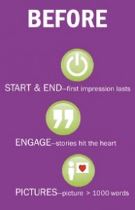Prior to the IFS World Conference, I shared ideas and inspiration to IFS employees on how to deliver a presentation that leaves a footprint in people’s mind. My message is that YOU as a presenter need to take center stage. Customers, prospects, analysts, colleagues and journalists should remember you as an individual. Then they will not only remember your message, but also share it with others.
In this post I want to share seven things to remember when you prepare and perform a presentation. I called it “The 7-up speaker technique.”
BEFORE YOUR PRESENTATION
Did you know that there are four versions of a presentation?
- The one you planned to do
- The one you actually did
- The one you wished you did
- The one the audience perceived
You can never judge which one of these four that is the best, because it differs from time to time and who you ask. This “theory” helps me to understand that a presentation depends on your performance at that exact moment. And, the more prepared you are, the better you will deliver.
Tip 1: START & END – Create a first impression that lasts
“A presentation has a start, an end and something in between.”
– Martin Gunnarsson
Your first two minutes in any presentation are the most important. The audience will analyze your personality, your clothes, your accent, your hair, how you walk, your slides—everything. They do so to decide whether it’s worth the investment to listen to you or not. During these two minutes, it’s difficult to digest detailed information. Instead, use this time to build trust, let the audience get to know you and build a relationship with them.
The START of your presentation should be something that is easy to understand and something everyone can relate to. Preferably a story or a topic that is unexpected so as to surprise the listener. This sends a signal that you feel safe in this situation. You build trust. The listener will also open up his/her senses to new influences as you do something unexpected and, therefore, the brain will be more open to receive new information.
At the END of your presentation, you have to tie together your presentation and messages. You have to clearly tell the audience what to remember after the session. Don’t be afraid to articulate it: “This is what you should remember from this session”. If you wish, you may also end your presentation with a story that is not necessarily related to the topic you talked about. This is more of a 30-second feel-good moment, to give the audience a final positive impression.
Tip 2: ENGAGE – Share stories that touch the heart
“Tell me and I will forget, show me and I will understand, engage me and I will remember” – Chinese proverb.
Logic hits the brain, stories hit the heart. Stories are the superglue between several messages. Stories are like pictures—you remember them better than mere facts. They are easier to remember and relate to.
Try to move the focus away from your PowerPoint slides and get the audience to remember YOU as a person. If they remember you, they will more easily remember your message(s).
Doing something physically on stage or using props will engage the audience as it will reinforce your message. I always use a prop in my presentations.
Personally, I have a vision that someone in the audience should mention me or my presentation to a colleague or family member at breakfast the next morning. To succeed, I have to touch their senses to remember me outside this context. Being a complete fool is one way, of course, but is not recommended. As always, you have to strike a balance between what is professional and what makes you looking like a clown. After all, we have to look professional and credible in all we do—but the opposite of being professional is not to be boring.
Tip 3: PICTURES – Use pictures with flair
“A picture is worth a thousand words” – Chinese proverb
One of the most common mistakes we make as presenters is when we use the PowerPoint slides as a script. It’s convenient to have most of what we want to say on the PowerPoint. But from an audience perspective, it’s a nightmare. No one can listen and read simultaneously. If you have lots of bullets, the audience will starting reading the page, and won’t be able to listen to what you say.
In an ideal world your PowerPoint slides should;
- reinforce YOU on the stage, not distract. Use pictures instead of lots of bullets
- not be used as speaker scripts: it should reinforce your message. Use speaker notes for speaker guidelines
- not be used as training material: it should reinforce your message. Use speaker notes for brief details about what you are going to say
DURING YOUR PRESENTATION
 You are now standing on stage and you are about to start your presentation. You feel comfortable with your slides and you have done your last-minute rehearsals. You feel strong. At this stage there is not much more to prepare. However, you are now very concentrated and excited and therefore it’s easy to forget a few things that will take your performance from good to great—or even awesome.
You are now standing on stage and you are about to start your presentation. You feel comfortable with your slides and you have done your last-minute rehearsals. You feel strong. At this stage there is not much more to prepare. However, you are now very concentrated and excited and therefore it’s easy to forget a few things that will take your performance from good to great—or even awesome.
There are four things you should remember during your presentation. To not forget these four things, please print this picture and put it on your computer keyboard as a reminder while presenting. I actually bring a print out with me of the “during” activities every time I present.
Tip 4: BODY LANGUAGE – Use your body language to rule the stage
You should be seen as a picture that communicates lots of information. The way you stand, walk and use your body sends signals about whether you are comfortable with the situation or not. If you look comfortable, the audience will be comfortable, will listen better and understand what you are saying.
Before the audience is seated, you should sit down and look at the stage to see where you should stand and walk on the stage. Ensure that you don’t end up too much to the left or right – it will look like you don’t dare to be seen or are not worth listening to.
Tip 5: SMILE – Smile at the audience
Smiling is one of the most powerful tools for demonstrating comfort and power. If you smile/look happy, you will send signals that you believe in what you say, that you have everything under control. But it’s not easy to smile if you are standing in front of a big audience and you are not used to it. That’s why you need a smile reminder. Because if you smile at the audience, they will smile back at you, and you will get lots of energy and self-confidence in return—a very positive spin-off effect to make you to perform better.
Tip 6: VOICE – Dare to pause
Dare to pause. People who are nervous talk too fast, which an audience notes immediately. If you dare to take brief pauses while looking at the audience to wait for a reaction, it signals that you’re comfortable as a presenter. But even better, making these pauses also lets you think about your next move, and you need this extra time to move from one topic to another in your presentation.
Tip 7: EYES – Look at all, not the wall
Try to get eye contact with “everyone” in the audience by regularly scanning through the whole audience. Avoid looking at people that are close to falling asleep as that makes you feel that you’re a bad presenter. Remember, that individual might just be very tired for any number of reasons! Try instead to make eye contact with people who look interested so as to boost your self-confidence.
It is so painful for an audience to listen to a presenter who looks at the projector screen 60% of the time. The reason for doing so is that you look in the same direction as the audience. If 50 people are staring at the wall, you feel that you too should be staring at the wall. THIS IS FORBIDDEN! If you print the slides on one or two pages, you only need to look at that paper to see where you are in the presentation and your notes. You actually don’t even have to look at the laptop (a glance is enough to verify that the right slide is showing).
I hope you found this useful.
I always use props to reinforce my message. During an internal pep-talk speech at the IFS World Conference I sang a song with the title “I love to talk” (new lyrics to “Fear of the dark” with Iron Maiden). Please add any feedback, additional presenting tips or your favorite props in the comments field below.



Muneera Sheriff
Great Tips Martin…!
Paul Collier
Great Post with some really important and simple points to follow.
When I coach I focus on the “Enjoy it” approach & outcome.
The presenter should acknowledge they are there for a reason and their knowledge is of value to the room, the audience also wants them to succeed and so the key is to be positive, embrace the opportunity and revel in it !! Enjoy!
Martin Gunnarsson
Hi Paul
You say that you coach. Do you have more information or tips you can share?
Thanks
Greg Romanello
Martin, thanks for the info — a good reminder that I can still improve: I don’t the rest but I need to work on #6. /Greg
Martin Gunnarsson
Greg, all american presidents (and candidates) have gone to the same rhetoric school where they learn how to make pauses. It symbolizes power. Try it, but it’s not easy.
Kristy Mills
Love this blog post Martin, it really got me thinking!
And as I have told you before I think you are a very effective and fun speaker to listen to. So great tips from a pro at IFS :)
mahjabeen
great blog love it